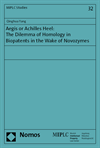Aegis or Achilles Heel: The Dilemma of Homology in Biopatents in the Wake of Novozymes
Abstract
Biopatents frequently disclose sequences of polypeptides and nucleic acids in the written description. The claims often cover a homology range surrounding the disclosed sequence to get a broader protection. However, homology claims face a hurdle that they may lack support by the written description. The Supreme Court of China ruled that homology claims lack support, but a further limitation by species of origin satisfies this requirement. This study explains that homology per se should have formed the essence of such disputes. Homology dictates the skilled person’s confidence on the functionality of unknown sequences, and is involved in multiple patentability requirements. Thus, the assessment of support is not an isolated matter. Disparity of different requirements creates an unclaimable gap, and constitutes a discrimination to biotechnology. An appropriate test for the support requirement is thus furnished to confer a scope of protection commensurating to the technical contribution.
Zusammenfassung
Biopatente offenbaren oft Polypeptid- und Nukleinsäuresequencen in der Erfindungsbeschreibung. Die Ansprüche decken oft einen Homologiebereich um die offenbarte Sequenz ab, um einen umfassenderen Schutz zu bieten. Bei mangelnder Stützuhng durch die Erfindungsbeschreibung steht Homologieansprüchen jedoch eine Schwierigkeit gegenüber. Der Oberste Gerichtshof Chinas hat entschieden, dass bei Homologieansprüchen eine mangelnde Stützung vorliegt; durch eine weitere Eingrenzung nach der Ursprungsart kann diese Anforderung jedoch erfüllt werden. Die vorliegende Studie erklärt, dass die Homologie selbst der Kern solcher Konflikte sein sollte. Die Homologie beeinflusst das Vertrauen einer Fachperson in die Funktionalität unbekannter Sequenzen, und ist Teil vieler Patentierungserfordernisse. Daher ist die Einschätzung der Stützung kein isoliertes Problem. Eine Disparität verschiedener Anforderungen erzeugt eine Anforderungslücke und stellt für die Biotechnologie eine Benachteiligung dar. Ein angemessener Test für die Stützungsanforderungen wird daher geliefert, um dem technischen Beitrag einen angemessenen Schutzbereich zuzuerkennen.
- 13–15 I. Introduction 13–15
- 64–66 VI. Conclusion 64–66
- Berg J, Tymoczko J and Stryer L, Biochemistry (2007)
- Burk DL and Lemley MA, ‘Is Patent Law Technology-Specific?’ (2002) 17 Berkeley Technology Law Journal 1155 doi.org/10.2139/ssrn.349761
- Chahine KG, ‘Enabling DNA and Protein Composition Claims: Why Claiming Biological Equivalents Encourages Innovation’ (1997) 25 AIPLA QJ 333
- Cremers K and others, ‘Invalid but Infringed? An Analysis of the Bifurcated Patent Litigation System’ (2016) 131 Journal of Economic Behavior and Organization 218 doi.org/10.1016/j.jebo.2016.08.005
- Dinarello C a, ‘Historical Review of Cytokines’ (2007) 37 European Journal of Immunology S34 doi.org/10.1002/eji.200737772
- Djamei A and others, ‘Trojan Horse Strategy in Agrobacterium Transformation: Abusing MAPK Defense Signaling’ (2007) 318 Science 453 doi.org/10.1126/science.1148110
- French S and Robson B, ‘What Is a Conservative Substitution?’ (1983) 19 Journal of Molecular Evolution 171 doi.org/10.1007/BF02300754
- Furniss CSM, Williamson G and Kroon PA, ‘The Substrate Specificity and Susceptibility to Wheat Inhibitor Proteins of Penicillium funiculosum Xylanases from a Commercial Enzyme Preparation’ (2005) 85 Journal of the Science of Food and Agriculture 574 doi.org/10.1002/jsfa.1984
- Fusco S, ‘TRIPS Non-Discrimination Principle: Are Alice and Bilski Really the End of NPEs?’ <https://papers.ssrn.com/sol3/papers.cfm?abstract_id=2653463>
- Luo G, Romance of the Three Kingdoms (XinXii-GD Publishing 2016)
- Heller MA and Eisenberg RS, ‘Can Patents Deter Innovation? The Anticommons in Biomedical Research’ (1998) 280 Science 698 doi.org/10.1126/science.280.5364.698
- Hodges RA, ‘Black Box Biotech Inventions: When a “Mere Wish or Plan” Should Be Considered an Adequate Description of the Invention’ (2001) 17 Georgia State University Law Review
- Kumar P and Satyanarayana T, ‘Microbial Glucoamylases: Characteristics and Applications’ (2009) 29 Critical Reviews in Biotechnology 225 doi.org/10.1080/07388550903136076
- Li C-X and others, ‘Genome Sequencing and Analysis of Talaromyces pinophilus Provide Insights into Biotechnological Applications’ (2017) 7 Scientific Reports 490 doi.org/10.1038/s41598-017-00567-0
- Lucas JM, ‘The Doctrine of Simultaneous Conception and Reduction to Practice in Biotechnology: A Double Standard for the Double Helix’ (1998) 26 AIPLA Quarterly Journal
- Marín-Navarro J and Polaina J, ‘Glucoamylases: Structural and Biotechnological Aspects’ (2011) 89 Applied Microbiology and Biotechnology 1267 doi.org/10.1007/s00253-010-3034-0
- Nielsen BR, Nielsen RI and Lehmbeck J, ‘Thermostable Glucoamylase’ <https://encrypted.google.com/patents/EP1032654B1?cl=nl>
- Prajapati VS, Trivedi UB and Patel KC, ‘Kinetic and Thermodynamic Characterization of Glucoamylase from Colletotrichum sp. KCP1’ (2014) 54 Indian Journal of Microbiology 87 doi.org/10.1007/s12088-013-0413-0
- Pearson WR, ‘An Introduction to Sequence Similarity (“homology”) Searching’ [2013] Current Protocols in Bioinformatics doi.org/10.1002/0471250953.bi0301s42
- Price D, ‘Energy and Human Evolution’ (1995) 16 Population and Environment 301 doi.org/10.1007/BF02208116
- Schrammeijer B and others, ‘Interaction of the Virulence Protein VirF of Agrobacterium tumefaciens with Plant Homologs of the Yeast Skp1 Protein’ (2001) 11 Current Biology 258 doi.org/10.1016/S0960-9822(01)00069-0
- Strahler AN, Science and Earth History: The Evolution/creation Controversy (Prometheus Books 1987)
- Vergunst AC and others, ‘Positive Charge Is an Important Feature of the C-Terminal Transport Signal of the VirB/D4-Translocated Proteins of Agrobacterium’ (2005) 102 Proceedings of the National Academy of Sciences 832 doi.org/10.1073/pnas.0406241102
- Woese CR and Fox GE, ‘Phylogenetic Structure of the Prokaryotic Domains: The Primary Kingdoms’ (1977) 74 Proceedings of the National Academy of Sciences, USA 5088 doi.org/10.1073/pnas.74.11.5088
- Wu W, ‘effective limitation by microbial species of origin in patent claims’ China Intellectual Property News (3 May 2017)
- Yamamoto F, ‘Review: ABO Blood Group system—ABH Oligosaccharide Antigens, Anti-A and Anti-B,A and B Glycosyltransferases, and ABO Genes’ (2004) 20 Immunohematology 3
- Yang Z, New insights on Intellectual Property Law – Detailed Analysis of the Theories and Practice (Sichuan University Press, 2009)
- —— A Study on the Scope of Patent Protection (Sichuan University Press, 2013)
- Zhu W, ‘After the Twists and Turns, Novozymes’ Protein Patent Is Finally Maintained’ China Intellectual Property News (15 March 2017)


